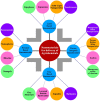Nanotechnological interventions for plant health improvement and sustainable agriculture
- PMID: 32206502
- PMCID: PMC7072078
- DOI: 10.1007/s13205-020-2152-3
Nanotechnological interventions for plant health improvement and sustainable agriculture
Abstract
Agriculture is the source of food for both humans and animals. With the growing population demands, agricultural production needs to be scaled up where nanotechnology can play a significant role. The use of nanotechnology in agriculture can manage plant disease and growth for better and quality output. Therefore, this review focuses on the use of various nanoparticles for detection of nutrients and contaminants, nanosensors for monitoring the environmental stresses and crop conditions as well as the use of nanotechnology for plant pathogen detection and crop protection. In addition, the delivery of plant growth regulators and agrichemicals like nanopesticides and nanofertilizers to the plants along with the delivery of DNA for targeted genetic engineering and production of genetically modified (GM) crops are discussed briefly. Further, the future concerns regarding the use of nanoparticles and their possible toxicity, impact on the agriculture and ecosystem needs to be assessed along with the assessment of the nanoparticles and GM crops on the environment and human health.
Keywords: Disease detection; Nanofertilizers; Nanopesticides; Nanosensors; Nanotechnology; Plant health; Sustainable agriculture.
© King Abdulaziz City for Science and Technology 2020.
Conflict of interest statement
Conflict of interestThe authors declare no conflict of interest.
Figures


Similar articles
-
Nanotechnology for sustainable agro-food systems: The need and role of nanoparticles in protecting plants and improving crop productivity.Plant Physiol Biochem. 2023 Jan;194:533-549. doi: 10.1016/j.plaphy.2022.12.004. Epub 2022 Dec 9. Plant Physiol Biochem. 2023. PMID: 36521290 Review.
-
A comprehensive overview of nanotechnology in sustainable agriculture.J Biotechnol. 2022 Aug 20;355:21-41. doi: 10.1016/j.jbiotec.2022.06.007. Epub 2022 Jun 22. J Biotechnol. 2022. PMID: 35752390 Review.
-
Nanotechnological Interventions in Agriculture.Nanomaterials (Basel). 2022 Aug 3;12(15):2667. doi: 10.3390/nano12152667. Nanomaterials (Basel). 2022. PMID: 35957097 Free PMC article. Review.
-
Nanotechnology in precision agriculture: Advancing towards sustainable crop production.Plant Physiol Biochem. 2024 Jan;206:108244. doi: 10.1016/j.plaphy.2023.108244. Epub 2023 Nov 30. Plant Physiol Biochem. 2024. PMID: 38071802 Review.
-
Nano-enabled strategies in sustainable agriculture for enhanced crop productivity: A comprehensive review.J Environ Manage. 2024 Dec;372:123420. doi: 10.1016/j.jenvman.2024.123420. Epub 2024 Nov 24. J Environ Manage. 2024. PMID: 39581009 Review.
Cited by
-
Termiticidal Effects and Morpho-Histological Alterations in the Subterranean Termite (Odontotermes formosanus) Induced by Biosynthesized Zinc Oxide, Titanium Dioxide, and Chitosan Nanoparticles.Nanomaterials (Basel). 2024 May 24;14(11):927. doi: 10.3390/nano14110927. Nanomaterials (Basel). 2024. PMID: 38869552 Free PMC article.
-
Impact of Sodium Alginate-Encapsulated Iron Nanoparticles and Soil Yeasts on the Photosynthesis Performance of Lactuca sativa L. Plants.Plants (Basel). 2024 Jul 25;13(15):2042. doi: 10.3390/plants13152042. Plants (Basel). 2024. PMID: 39124160 Free PMC article.
-
The Applications of Nanotechnology in Crop Production.Molecules. 2021 Nov 23;26(23):7070. doi: 10.3390/molecules26237070. Molecules. 2021. PMID: 34885650 Free PMC article. Review.
-
Smart nanomaterial and nanocomposite with advanced agrochemical activities.Nanoscale Res Lett. 2021 Oct 18;16(1):156. doi: 10.1186/s11671-021-03612-0. Nanoscale Res Lett. 2021. PMID: 34664133 Free PMC article. Review.
-
Nanotechnology advances for sustainable agriculture: current knowledge and prospects in plant growth modulation and nutrition.Planta. 2021 Sep 7;254(4):66. doi: 10.1007/s00425-021-03714-0. Planta. 2021. PMID: 34491441 Review.
References
-
- Abad E, Palacio F, Nuin M, De Zarate AG, Juarros A, Gómez JM, Marco S. RFID smart tag for traceability and cold chain monitoring of foods: demonstration in an intercontinental fresh fish logistic chain. J Food Eng. 2009;93(4):394–399.
-
- Al-Hiary H, Bani-Ahmad S, Reyalat M, Braik M, ALRahamneh Z. Fast and accurate detection and classification of plant diseases. Int J Comput Appl. 2011;17(1):31–38.
-
- Amador C, Emond J-P, do Nascimento Nunes MC. Application of RFID technologies in the temperature mapping of the pineapple supply chain. Sens Instrum Food Qual Saf. 2009;3(1):26–33.
-
- Anschütz U, Becker D, Shabala S. Going beyond nutrition: regulation of potassium homoeostasis as a common denominator of plant adaptive responses to environment. J Plant Physiol. 2014;171(9):670–687. - PubMed
-
- Anton N, Benoit J-P, Saulnier P. Design and production of nanoparticles formulated from nano-emulsion templates—a review. J Control Release. 2008;128(3):185–199. - PubMed
Publication types
LinkOut - more resources
Full Text Sources

